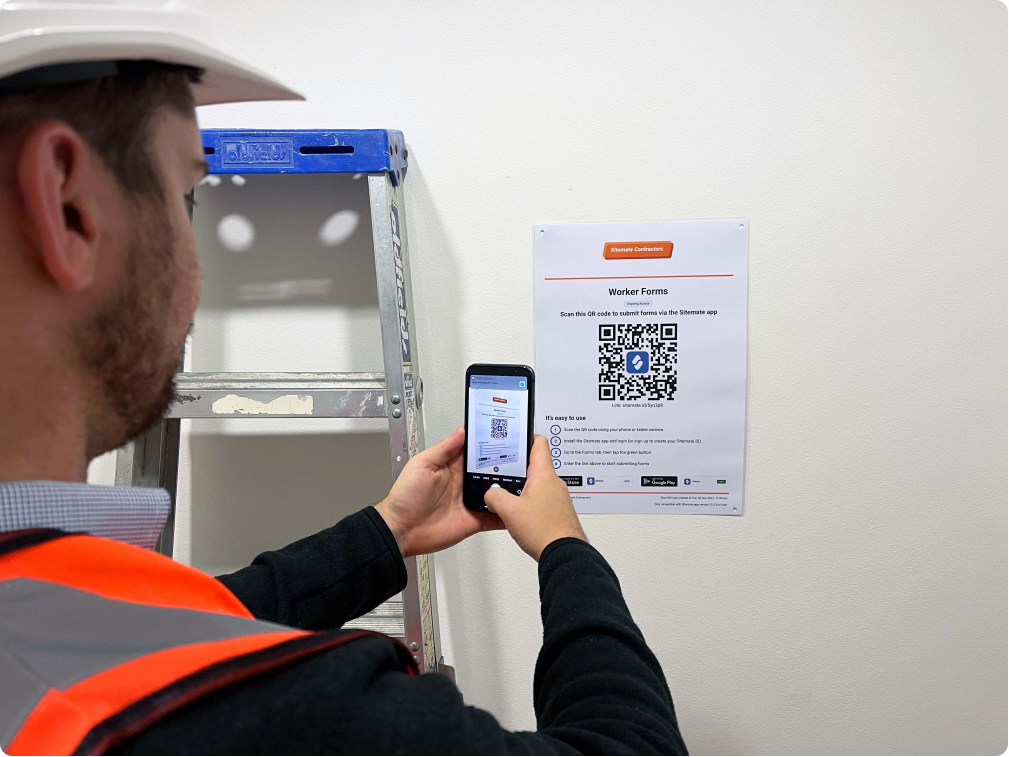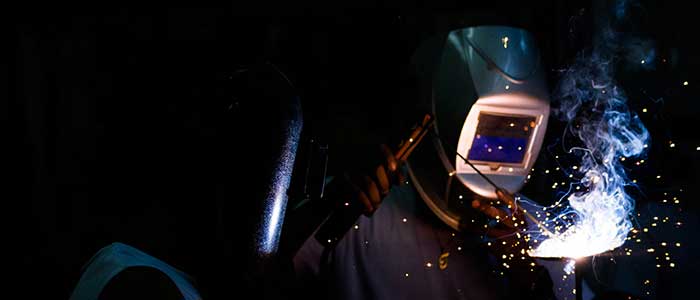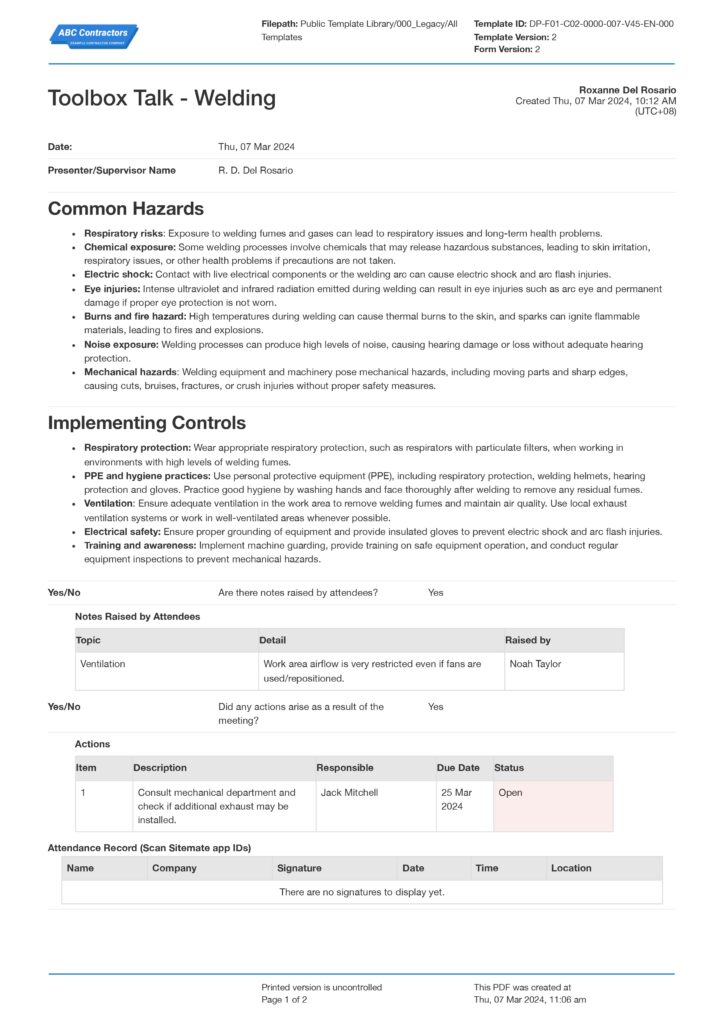Dashpivot Article – Welding Safety Hazards
Welding Safety Hazards
Welding, while an essential activity, has hazards that companies need to acknowledge. In this article we will be tackling these safety hazards and sharing a toolbox form to help you cover the most important welding safety hazards with your team.

Welding in the Industry
Welding is an activity that conjoins two materials together by using heat or pressure. The Egyptians discovered this method of soldering two metals, and it has been in use since 3000 BC. Later in Russia, by the year 1881, Nikolay Benardos invented and introduced carbon arc welding. Over the course of years, welding has seen major advancements in terms of both its technical and practical aspects, resulting in increased precision, speed, and efficiency. Innovators continuously study these processes to enhance the techniques and machines involved in the activity. Welding is highly common and popular in the construction, transportation, and shipbuilding sectors.
Welding Safety Hazards
While welding is useful in so many industries, we can’t deny the fact that this activity brings along hazards that could potentially injure the workers and also damage properties. It is important that these hazards are identified so that the right safety measures can be put in place to shield people from them. To help you identify these hazards, we will be listing the most common and prominent ones associated with the welding activity. Here are the welding safety hazards:
Welding Safety Hazards - Fire Hazards
Welding primarily involves using intense heat to weld two pieces of material together. Because of the presence of this heat, welding is automatically classified as a fire hazard. Additionally, welding also produces multiple sparks that fly off when doing the activity. These sparks can potentially ignite the light materials around them and cause fires.
Acknowledging welding as a fire hazard can help companies better safeguard the activity. Measures like creating a safe work method statement for welding can further polish procedures by integrating safety measures into them. This will eliminate the possibility of the activity causing fires, which can injure the personnel and destroy property.
Burns
Given that welding poses a fire hazard, conducting the activity also carries a significant risk of burns. Burns are a form of injury that occurs when anything hot causes damage to the tissues of your body. They get more severe as they penetrate deeper into your body and cover a greater portion of its surface.
Three scenarios exist where a worker may sustain burns during welding. One is that his skin directly contacts a hot surface. Two is due to the intense light emitted when welding. And lastly, it would be due to electrocution. To prevent burns, we must ensure that the safety measures in place cover these three factors.
Electrical Hazard
Most modern welding equipment heavily relies on electricity to power it and to generate the heat required to solder the materials. One of the procedures of these welding machines is to provide a wire for the ground terminal. The purpose of this is to complete the electrical circuit where the current returned to the machine is dispelled to the ground and to protect welders and the machine from stray electrical discharge.
However, although it is designed as a safety feature on the machine, it can ironically become a cause of electrocution if not used properly. When there is improper grounding, it can lead to serious hazards. Contributing factors to these are damaged wires and grounding on conductive ground (metals and wet surfaces). Businesses should ensure that proper procedures with the correct measures are followed when grounding a welding machine.
Dangerous Fumes
Naturally, welding creates fumes as a byproduct. These fumes are created when a metal is heated over its boiling point, which, as a result, causes the metal's vapors to condense into tiny particles, producing fumes. Welding fumes are usually a combination of fluorides, silicates, and metallic oxides.
Immediate effects of inhaling welding fumes are irritation in the lungs, metal fume fever, and nausea. Long-term exposure can lead to critical and permanent conditions like chronic respiratory diseases (bronchitis and pulmonary fibrosis), neurological damage (manganism), and lung cancer. Welding activity should not disregard fumes. Measures must be taken to eliminate or reduce exposure to welding fumes.
Blinding Light
Like fumes, the generation of a very bright light is a natural part of welding. This brightness is created by the intense heat during welding, where the welding arc ionizes the air and materials being welded, creating a concentrated plasma of ultraviolet and infrared radiation, which appears as the very bright light we perceive.
These types of light are harmful to the human eyes. Direct exposure to light at close proximity can damage the clear outer layer of your eyes, known as the cornea. When this happens, you will feel an intense burning feeling in your eyes (basically a sunburn in your eyes). This condition is called photokeratitis or, as it is commonly known, welder’s flash. Additionally, infrared radiation is produced because of the high heat welding emits. This radiation can damage to internal eye tissues, which can cause permanent eye conditions such as cataracts.
Working with Sharp Objects
Most of the time, personnel who are welding will be exposed to things that have sharp edges. This is particularly true in workshops that specialize in manufacturing and shipbuilding. If they are not handled with attention and care, these sharp items have the potential to inflict significant cuts and lacerations on the skin. In light of this, it is essential that workplaces develop and enforce measures such as the correct use of personal protective equipment (PPE).
Limited Senses
PPEs, while they protect us from the hazards during welding, can also become the source of hazards themselves. One of the dangers that it poses is that they limit our senses. The perfect example to give light to this is the welding mask. The welding mask is designed to protect the welder from the flying sparks and the harmful light it emits.
However, wearing the mask limits our sense of sight, which exposes us to other dangers in the surrounding area. Because of this, the welding activity should never be a one-man job. If possible, when welding, two people should be involved to act as a spotter and a substitute.
Welding Safety Hazards associated with Dangers in Confined Spaces
There are situations where the dangers of welding can escalate. Welding is already an inherently dangerous activity in itself, and the risks of hazards can be further enhanced when done in certain conditions. One of these conditions is working in confined spaces. We have already talked about how inhaling welding fumes can be dangerous to human health.
In confined spaces, these fumes are trapped and have nowhere to escape to. This can be an extremely critical condition if fumes were to build up inside a confined space where a person is working. This situation has the possibility to take a human life. Companies must always consider and plan the activity before beginning actual work, especially in situations where dangers are potent enough to kill somebody.
Safety talks around Welding Safety
Toolbox talks are short, informal topics that discuss safety. This can be the right avenue to discuss these welding safety hazards , spread awareness, and develop a safety culture in the workplace. To conduct a toolbox talk effectively, you need a toolbox talk form. This form outlines the safety topic and has fields to record all concerns raised in the meeting. This form will also serve as a process development material, since all concerns here can be provided with solutions to further establish a safer process. To understand how the form should look, take a look at the example given below.

Hold better safety talks using this form for free.
Welding Safety Measures to Combat these Hazards
As repeatedly mentioned above, proper measures must be laid out when doing a welding activity. In this section we will introduce to you a few effective measures that can help you conduct a safe welding activity.
Field Risk Assessments
Field-level risk assessment is a tool for identifying hazards. This tool requires you to review the procedures of a certain activity and identify the hazards in each step. When the hazards are identified, a risk scoring is conducted to know the effectiveness of the safety measures needed. With the field-level risk assessment, all hazards will be addressed and controlled, eliminating or reducing the possibility of harm.
Certified Personnel
It should be mandatory for businesses to employ qualified and skilled welders. Otherwise, they have to educate them and get credentials. Welders who have earned certification have completed courses that have equipped them with the information and skills necessary to recognize risks and steer clear of actions that increase the activity's risk. Welding jobs are more effective and less prone to mistakes when done by skilled welders, which benefits the business.
Welding as a Team Activity
Companies should acknowledge welding as an activity that needs more than one person. Assigning a single person to do the welding activity can prove to be dangerous, as mentioned awhile ago. Such an arrangement also lessens a person’s exposure to the harmful effects of welding, since the worker can have a substitute in the work. They can alternately take turns when doing the welding job. The substitute can also act as a fire watch and a spotter during welding work, protecting the person from any harm while doing the welding activity.
Equipment Inspection
To prevent any electrocution because of torn-off wires and malfunctions, proper maintenance must be done on the welding machine. One of the most effective tools you can use as a preventive maintenance procedure on the machine is to conduct an equipment inspection. These evaluations can help check on damages, which could lead to hazards like electrocution. With regular inspections, you can always guarantee that the equipment is safe to use.
Emergency Preparedness
In the event of an emergency, personnel are required to know what to do if ever it occurs. Since welding is well known to cause fires, emergency procedures must always be inculcated into the minds of the workers who are assigned to this activity. The best way to do this is to create an emergency action plan. Emergency action plans identify sources of possible emergencies and create procedures that help workers get out safely in the situations. Conducting drills on these procedures would help retain the procedures of the plan and build confidence to know what to do in case of an emergency.
Mitigating Welding Safety Hazards using Technology
The world of welding has been filled with welding technology for a long time, but it is now starting to include other aspects of technology, including the use of proper data capture and information acknowledgement tools.
Many welding companies and operations now erect QR code posters which link to pre start templates and other safety documentation which workers need for safety and compliance purposes.
This way, workers can prompted to actually submit a risk assessment, job safety analysis or similar, which steps them through and have them acknowledge the steps they need to take to reduce welding safety hazards right now.
This is great for workers, and also ensures that a company is compliant from a safety perspective, as everything is documented and stored properly.
Almost all of the common welding safety hazards we discussed can be linked back to better information sharing, which can be really streamlined through proper technology.

Welding is a dangerous activity and occupation, and likely always will be. But like with all aspects of workplace safety, there are a number of daily measures we can put in place to limit welding safety hazards for our teams, and we have highlighted a number of them above.

Safe Work Method Statement for Welding template
Keep all of your welding operations and all of your welders as safe as possible by maintaining a trusted and reliable source of truth on welding safety.

Safe Work Method Statement for Hot Works template
Improve how hot works are conducted and managed across your workforce and sites by keeping a standardised and trusted SWMS.

Job Hazard Analysis for Hot Work template
Manage the hazards around hot work and the hot work PPE required with this Job Hazard Analysis for hot work.

